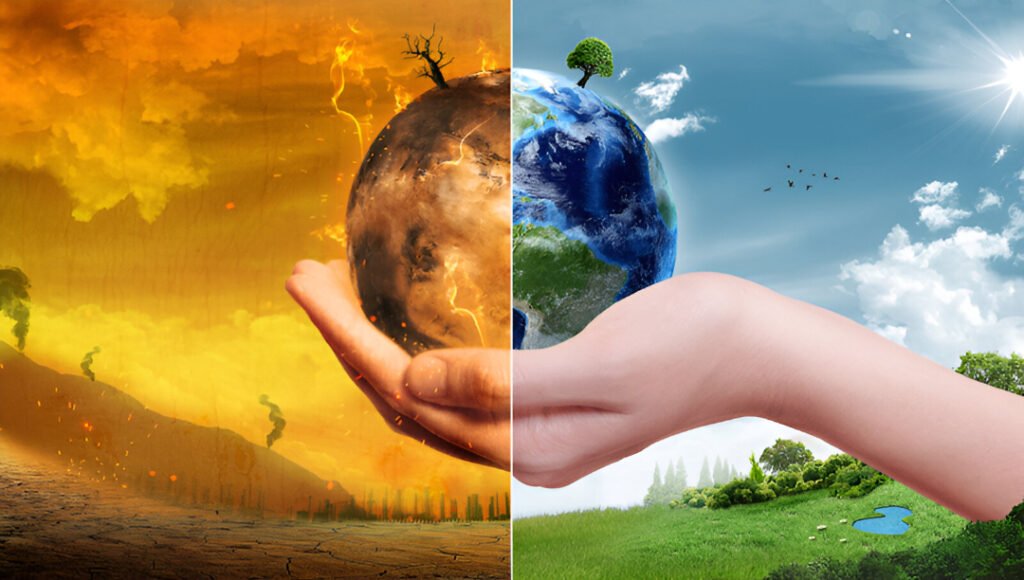
Quick summary—why the science matters
Climate change is not a distant theory—it’s a measured reality. Multiple independent datasets show the planet is warmer than preindustrial times, greenhouse gases are at record levels, oceans are heating and rising, and extreme weather is intensifying. Understanding these core facts helps people, communities, and policymakers make better decisions about mitigation and adaptation.
What causes climate change (the simple physics)?
The primary driver is the greenhouse effect: gases like carbon dioxide (CO₂), methane, and nitrous oxide trap heat that would otherwise radiate to space. Human activities—burning fossil fuels, clearing forests, and industrial processes—have sharply increased atmospheric greenhouse gas concentrations since the Industrial Revolution, enhancing this natural effect and warming the climate. That mechanism is supported by decades of atmospheric physics and observations.
Four lines of hard evidence
- Air temperatures: Global surface temperatures are at record highs; 2024 was one of the warmest years on record, placing long-term warming trends well above late-19th-century averages.
- CO₂ concentrations: Atmospheric CO₂ is above 420 parts per million (ppm) and rising—levels not seen for millions of years. Mauna Loa measurements and global monitoring show steady year-on-year increases tied to fossil fuel emissions.
- Ocean warming & heat content: The oceans absorb more than 90% of excess heat; ocean heat content reached new highs in recent years, driving marine heatwaves, coral stress, and altered weather patterns.
- Sea level rise and ice loss: Global mean sea level has risen roughly 8–9 inches (21–24 cm) since 1880, and the recent rate of rise has accelerated—roughly doubling over the last three decades—largely due to melting ice sheets and thermal expansion.

Observed impacts already in motion
Scientists link rising temperatures and ocean heat to more frequent and severe heatwaves, heavier rainfall and floods in many regions, longer droughts in others, and stronger tropical storms where warm oceans fuel intensity. In 2024 and 2025, international assessments and “State of the Climate” reports documented record heat, unusually humid heat days, and a surge of climate-related disasters—reinforcing that these changes are already affecting people, ecosystems, and economies.
What are the best science projects for the future?
The IPCC’s synthesis of current research is clear: human influence on the climate is unequivocal, and without rapid, deep cuts in greenhouse gas emissions, global temperatures will continue to rise. There is a meaningful chance of temporarily crossing 1.5°C above preindustrial levels in the near term; longer-term outcomes depend on emission trajectories and policy choices. Mitigation (reducing emissions) and adaptation (preparing communities) are both essential.
Practical actions at every level
- Global & national policy: Rapid decarbonization of electricity, transport, industry, and buildings; emissions pricing; and scaled investment in clean energy and storage are the backbone of staying near lower-warming pathways.
- Local & community resilience: Strengthen early-warning systems, update flood maps, invest in heat mitigation (green spaces, cooling centers), and protect coastal infrastructure.
- Individual choices: Lower emissions where feasible (energy-efficient homes, low-carbon transport, plant-forward diets), support durable goods over disposables, and vote for leaders who prioritize climate science and policy. While systemic change matters most, individual actions add up and shape social and market trends. (Broad guidance synthesized from policy and academic reports.)

Uncertainties—what scientists are still refining
Climate models robustly capture large-scale warming but differ on regional precipitation changes, the timing of ice-sheet responses, and complex feedbacks (for example, how permafrost thaw might release more methane). That uncertainty is not a reason for inaction; it means preparedness and flexible policy design are crucial.
Bottom line: the science is clear—urgency is not optional.
Multiple, independent lines of evidence converge: human activities are warming the planet, consequences are already significant, and prompt mitigation plus adaptation will reduce long-term harm. For individuals and leaders, the takeaway is straightforward: use the science to accelerate emissions reductions, invest in resilience, and back policies that align short-term choices with long-term stability. Every fraction of a degree avoided limits damage—and the next decade matters most.











